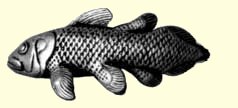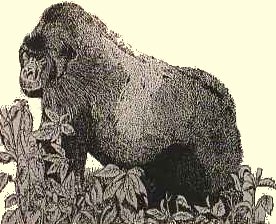Examples
The Great Heroes of Cryptozoology
Here are listed the shining examples of just what we mean, the animals that stand out in my mind. These animals were either refuted by the scientific establishment, or presumed extinct. They show us that we have much left to explore, much left to discover, in the discipline of zoology. Each is examined in detail, for it is the details that are really important.
Each of the animals below stands out because the story behind it's discovery, the legend of it's existence, or the behavioral characteristics of the animal, are unique and of interest to the cryptozoologist.
In reality, there are several thousand animals of study interest to the cryptozoologist, each with it's own story, it's own secrets to add to a particular puzzle. Here then is just a 'sampler' of some key species and the information about each that is important to our research.
Subjects
The Coelocanth
The Mountain Gorilla

The Coelocanth
To say this fish is important to the field of cryptozoology is like saying the Rosetta Stone was a factor in deciphering the Egyptian hieroglyphs. The Coelocanth is litterally a 'living fossil'. A living fossil is a species that was known only from the fossil record until a live specimen was discovered, and one assumed to have gone extinct millions of years ago.
It is increasingly hard to find references to what was believed about this fish before it turned up alive, but the general consensus is that it was believed to live in the shallow inland seas and went extinct about 65 million years ago. In 1938, the animal turned out to be very much alive and living in deep water.
The Coelocanth is an example of a species that was commonly known by the native fishermen who occasionally caught them, yet completely unknown to science until one happened to spy a specimen in a fish market by complete chance. It is also a glaring light of warning that paleontology does not hold all the answers, that their answers are often wrong.
Hopefully the coelocanth taught many scientists a lesson on humility. It is refreshing that as we enter a new century, most young scientists are hesitant to declare absolute truths and have a more open-minded approach to their studies.
Just because one fish somehow survived when it was assumed extinct does not mean there are others waiting to be found, but cryptozoology is not about certain declared truths, we would not presume to declare the truth as mainstream science does, and frequently gets wrong. All we ask is the simple question: "Is it possible there are more?" The answer is certainly 'yes'.
The last, and perhaps most ominious lesson of the Coelocanth, is that the initial identification of it was that it was a 'freak of nature' and of no concern. This teaches us that scientists are people, like the rest of us. There are good scientists and bad scientists. Bad ones will balk when confronted with the new and unknown, will refuse to look at the evidence and fall back on the outdated unwritten law of skepticism. They allow personal beliefs and prejudices to interfere with their work, assisting in the supression and disgarding of evidence.
How many unknown sea creatures have been dismissed as 'freaks of nature' and thrown into trash bins over the years? I cringe to consider the number.

The Mountain Gorilla
"In 1847 two American explorers, Thomas Savage and Jeffries Wyman, presented a paper to
the Boston Society of Natural History describing žA new species of Orang from the Gabon riverÓ
but it was not until the 20th century that the mountain gorillas of Rwanda were discovered by the
outside world.
In October 1902, a German army officer, Captain Oscar von Beringe, shot two unknown apes
whilst climbing Mount Sabinyo in the Virunga volcanoes as part of an expedition to establish the
boundaries of German East Africa. He recovered one of them from the ravine it had fallen into
and it became the type specimen for Gorilla g. beringei - the true mountain gorilla."
from: http://www.gorillas.org/ - The Dian Fossey Gorilla Fund.
The Mountain gorilla is an example of a rumoured species that was refuted my science until the dead body of one was presented to them. This highlights the greatest challenge to cryptozoology - proving the existence of an animal without a physical body. The gorilla also gives us many clues as to the possible nature and habits of another great ape - the Sasquatch, North America's great ape. Proving such an animal exists without a body is the goal.
It is also amazing that a large mammal went undetected by science in the African jungles until 1902. It is easy to dismiss this as it was over 100 years ago, but keep in mind the prevailing world opinion of the time. Science was convinced it had conquered the natural world and that there were no more great zoological discoveries to be had. This opinion is echoed forward to present day. They are as wrong now as they were then.
Note: The Mountain Gorilla is one of the most endangered species in the world, with a wild population estimated at less than 650 individuals. Recent developments in the civil war in the Congo and attacks on the gorillas by these soldiers may have reduced this number to unrecoverable levels. May we all hang our heads in disgrace.